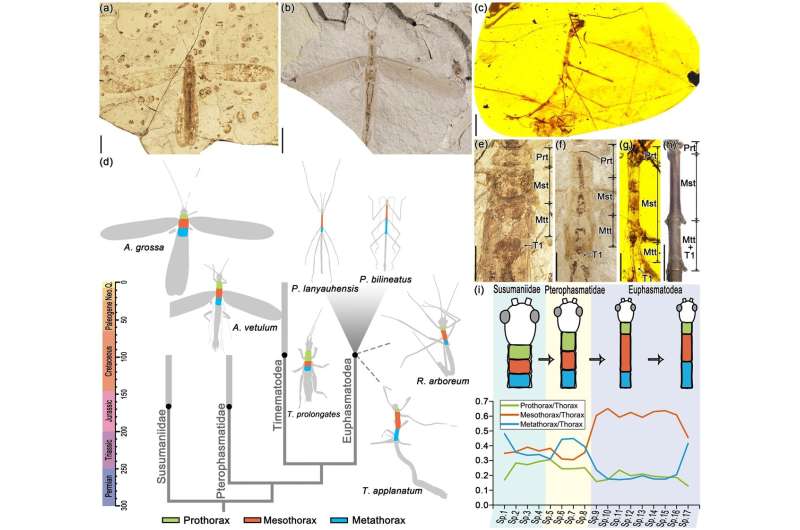The early evolution of successful twig mimicry in insects

Twig mimicry is most common and diversified in Phasmatodea (stick and leaf insects), a group of iconic models for understanding the evolution of camouflage and mimicry among insects. Extant stick and leaf insects exhibit a wide array of exaggerated morphologies mimicking twigs, bark, fresh or dried leaves, ferns, and even moss. However, the fossil record of Phasmatodea is relatively sparse, and the most ancient stick insects from 100 million years ago lack obvious characteristics relating to the familiar twig mimicry of the extant groups.
In a paper published in Science Bulletin, researchers from Capital Normal University and their colleagues studied and analyzed three taxonomic groups of stick insects from two Mesozoic periods, the Middle Jurassic of 165 million years ago and mid-Cretaceous of 99 million years ago. These species revealed a possible trend in body shape evolution among early stick insects, transitioning from those with a stout body among the stem group of Susumaniidae to a relatively slender body within Pterophasmatidae, and ultimately to the nearly twiglike form of crown-group Euphasmatodea.
To further clarify this evolutionary trend, the researchers measured the widths and lengths of the body parts of all well-preserved specimens from the Mesozoic, revealing that there has been a significant increase in the ratio of the mesothorax/thorax and metathorax/thorax, but the ratios of the prothorax/thorax declined only slightly by comparison.
This suggests that not only did the body become more slender, but during early phasmatodean evolution the mesothorax and metathorax became more distinctly elongated relative to the prothorax. It appears that stick insects with twig mimicry increased the ratio of the body (length/width) and became slender while the prothorax shortened and the mesothorax and metathorax were lengthened. Subsequently, the metathorax was gradually fused with the first abdominal segment, and the legs were concomitantly lengthened and became thinner, ultimately bringing about a long twig body form.
The researchers argue that these changes were concomitant with the diversification of flowering plants, the primary food source for stick insects to this day. Angiosperms rose to prominence during the Cretaceous, providing at that time a critical environment and diversity of resources to the appearance of refined systems of twig mimicry, aiding the diversification of stick insects.
More information: Hongru Yang et al, Mesozoic insect fossils reveal the early evolution of twig mimicry, Science Bulletin (2022). DOI: 10.1016/j.scib.2022.07.007
Provided by Science China Press



















